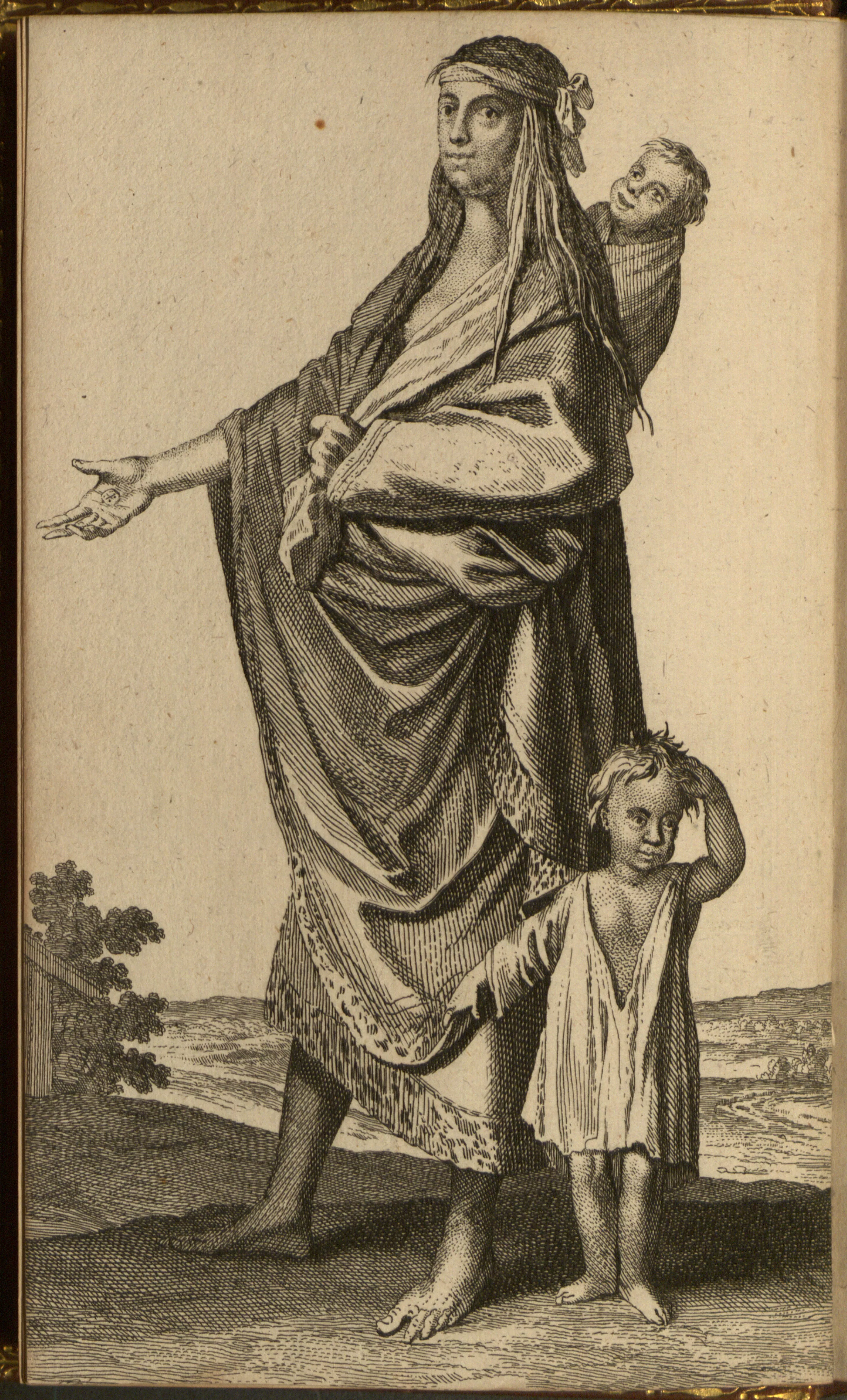Exhibit
Creation Date
1807
Height
20 cm
Width
12 cm
Medium
Genre
Description
A woman travels through a landscape with two children: an infant held to her back in a shawl, and a young child who stands beside her and holds the hem of her cloak. The woman has long hair and a scarf tied around her forehead; she clutches the shawl in which the infant rides with her left hand, and extends her right to reveal a coin. Both mother and child are barefoot, and the child’s tunic only partially covers his body. The gypsy featured in this image, though the assumed mother of the two children, is depicted as particularly masculine in her physique.
Ethnographic images such as these strove to classify gypsies as an identifiable racial group and to differentiate between particular types of gypsies (such as the rugged, Amazonian gypsy woman and the decrepit and elderly gypsy hag). Such images were included in both encyclopedic volumes of novel persons, which attempted to archive eccentric types, and more focused, scholarly treatises on the supposed cultural and biological differences of England’s domestic other.
The 1744 Vagrancy Act mandated that gypsies, beggars, strolling actors, peddlers and gamblers refusing to work for usual or common wages could be whipped or imprisoned by local magistrates (Mayall 258). In this way, any person refusing to participate in a wage-based system of labor was deemed criminal. The 1810 Licensing Act required the licensing of vagabonds, gypsies, hawkers and peddlers (Hawkes 13). This system of identification contributed to the surveillance of wandering persons and helped to enforce local ordinances specifying the maximum stay of non-residents in a town or its outskirts.
Throughout this period legal settlement remained a prerequisite for poor relief, meaning that the illegally settled, unsettled or wandering poor were routinely excluded from community or church-based assistance (Lloyd 117). Through the so-called “Speenhamland system,” parishes subsidized wages according to the parishioner’s need, determined by the cost of bread and number of dependents (Lloyd 115). In this way, most discussions of poverty revolved around the adequacy or inadequacy of earnings, and thus excluded those who did not participate in a wage-based economy.
The woman’s elongated stature illustrates the belief that gypsy women were made more rugged and masculine by the hardships of a nomadic existence, an idea echoed in Wordsworth's "Beggars" (quoted above). This construction of the gypsy was one of many ways in which their peculiarity as a distinct race was conceptualized as a result of environment and lifestyle rather than an intrinsic or biological difference (Nord 14). The prominent placement of the young child exposed to the elements and Grellmann’s description of the mother’s parental neglect suggests the specific interest in children’s welfare taken up by many philanthropic and charitable organizations at the beginning of the nineteenth century, a focus that would become more pronounced as the century progressed (Olsen 29).
Collection
Accession Number
Thordarson T 1836
Additional Information
Bibliography
Grellmann, Heinrich Moritz Gottlieb. Dissertation on the Gipseys. London: William Ballintine, 1807. Print.
Hawkes, Derek and Barbara Perez. The Gypsy and the State: The Ethnic Cleansing of British Society. Oxford: Alden P, 1995. Print.
Lloyd, Sarah. “Poverty.” An Oxford Companion to the Romantic Age: British Culture 1776-1832. Ed. Iain McCalman, et al. Oxford: Oxford UP, 1999. 114-125. Print.
Mayall, David. Gypsy Identities 1500-2000: From Egipcyans and Moon-men to the Ethnic Romany. New York: Routledge, 2004. Print.
Nord, Deborah Epstein. Gypsies & the British Imagination, 1807-1930. New York: Columbia UP, 2006. Print.
Olsen, Kirstin. Daily Life in 18th-century England. Westport: Greenwood P, 1999. Print.
Wordsworth, William. "Beggars." Selected Poetry. Ed. Stephen Gill and Duncan Wu. Oxford: Oxford UP, 1997. 119. Print.

